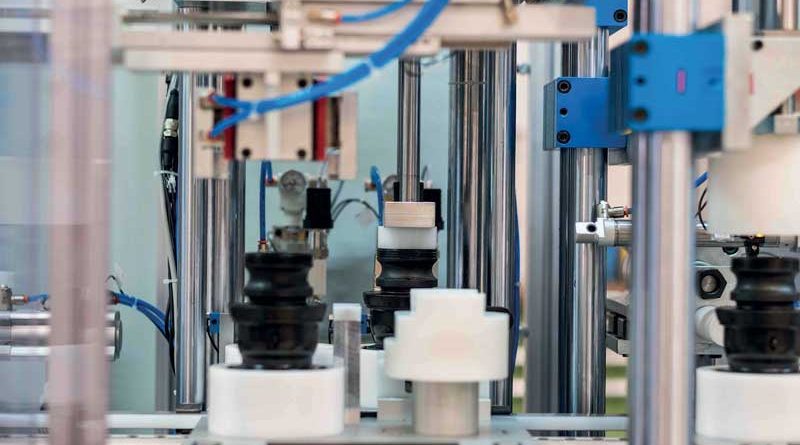Concretely Cutting-edge
The year 2018 is an important one for Automac, which celebrates the 25th anniversary of its foundation and continues to look for innovative solutions every day in order to create assembly lines with an increasingly mechatronic soul. An example? A line for the assembly and testing of a new model of screw-in plastic ball valve that guarantees a production rate of 350 pieces/hour.
by Fabrizio Dalle Nogare
However inflated and, perhaps, rhetoric, the image of a company that is founded in a basement only thanks to someone’s passion and will to take risks is still poetic. That is how, in 1993, Automac’s story began, becoming one of the leading companies in the field of automation/assembly and mechatronics.
“We started by designing our machines on a drawing board, while today we have advanced 3D design tools”, says Franco Perico, who has been at the head of the company since the very beginning. We met him at their headquarters in Bottanuco (BG). “This shows how the industry has undergone real upheavals in the last 25 years, starting from the technology applied to the machines, which were once designed for a single product, mainly mechanical, difficult to maintain, reconvert, and fine-tune. Today, however, with the advent of mechatronics, our work is perhaps more complicated, but at the same time we make life easier for our customers, who have available machines that are convertible, flexible and designed to process more products. In automation and assembly plants, in my opinion, the essence of Industry 4.0 is condensed, and I am not just referring to production traceability”.
At the service of the territory and of people
Ingenuity, innovation and flexibility are the three key words that best describe the path completed by Automac. A path that has led the company to a turnover of over 3.3 million euro in 2016 and this has been growing steadily since the crisis years.
And if the automotive industry (with a long-standing collaboration with a global brand such as Brembo) has been the sector that, according to Mr Perico, has allowed Automac to achieve production standards to be applied in other sectors, assembly systems have been built for many sectors over the years: from locks to handles for doors and window fixtures to the electrical sector, industrial vehicles and valves and plastic components, as we will see later.
“Underpinning all this – adds Mr Perico – there has always been teamwork, combined with the trust that binds us to collaborators and suppliers, together with the ability to remain ourselves in our common deepest feeling and to put ourselves at the service of the territory and of people“.
An automatic machine for assembling 350 valves per hour
Being from Bergamo – one could say – concreteness is Automac’s style, even more so at a time of market recovery. The Bergamo-based company has recently developed a special automatic line for the assembly and testing of a screw-in plastic ball valve. The plant has a production rate of 350 pieces per hour.
“The automatic machine, designed and built for a customer who needed to assemble a new valve model, is designed to optimize production and reduce cycle time as much as possible – explains Mr Perico – beginning with the robotized system that loads the valve body, the upper body and the shaft-lever unit”.
Even before they are transferred to the line, the inner side of both the valve body and the upper body is sheared off. Two circular self-distributors feed both the gaskets to be inserted into the component – which are also lubricated – and the balls to be inserted into the valve body after being correctly oriented.
The valve body and the upper body are then welded by ultrasonic welding and repositioned on the line. The dust resulting from this operation is removed by blowing.
The last stages of the assembly process
At this point, a double automatic station carries out the leak test, which is fundamental for this product. Then the shaft-lever unit is inserted into the valve body with the aid of a pneumatic manipulator. Another automatic station takes care of screwing the caps, which are fed and directed by a circular self-distributor, on the valve body. A pin is also inserted on the body to lock the valve in the closed position. Before the final unloading there is an automatic station where the lower gasket is inserted into the valve body. The last step is the lever marking, which is performed by a laser system for marking the product code and traceability data.
Training is the key to the future
“Each machine has cutting-edge technological solutions: a continuous encouragement for designers”, says Mr Perico. “This is also a way to build trust relationships with customers, who appreciate those who are able to offer their know-how. I have always believed that in a company, and especially in an ever-changing sector like ours, skills are what really matters”.
Looking ahead, then, and in line with the path traced by AIdAM, the development of young talent skills is linked to a strong and successful relationship with educational institutions. “We really believe in internships and school-work programs, which makes it possible to fill the gap between education and life in a company, not only considering the technical preparation but also how to become part of a working group. Even business owners must do their part and work actively to put the younger ones in the best position to learn a job that is certainly not simple but charming, stimulating interest in their work”. 25 years have passed, but the passion has remained unchanged and the ideas, on the other hand, are always new and projected to the future.

